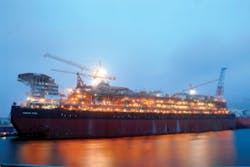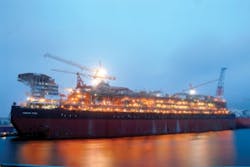Paula Dittrick
Senior Staff Writer
A growing percentage of oil and gas reserves worldwide are in deep water, calling for new technologies to operate safely and reliably under enormous pressures and temperatures, BP America Inc. Chairman and Pres. Lamar McKay told the Offshore Technology Conference in Houston on May 3.
"The deepwater is indispensable to the world's energy future," McKay said during a breakfast speech. "Indeed, we estimate that the percentage of world oil production coming from the deepwater will rise to around 10% by 2020." He believes industry can safety drill in 10,000-12,000 ft of water.
Helix Well Containment Group (HWGC) on May 3 announced the availability of a 15,000 psig intervention capping stack designed to handle extremely high pressure, deeper wells in the gulf. Photo from HWCG.
BP is determined to enhance deepwater safety and response capabilities, he said. BP operated the Macondo well off Louisiana. An April 2010 blowout resulted in an explosion and fire on Transocean Ltd.'s Deepwater Horizon semisubmersible, killing 11 crew members. The semi later sank, and a massive oil spill resulted.
McKay said BP and industry are working to convert lessons learned from the oil spill response efforts into "focused sustainable enhancements" to spill prevention, drilling safety, and containment efforts in case of future deepwater well blowouts.
BP mobilized two top hats to the UK North Sea, he said. BP is working with the Oil Spill Prevention and Response Advisory Group on design and construct a next-generation capping stack, he said.
"Almost all of the containment equipment used and developed during the Macondo response, whether or not it was deployed, has been made available to the Marine Well Containment Co. (MWCC) of which BP is a permanent member," McKay said.
MWCC is a consortium primarily of oil majors to provide oil containment systems in case of future deepwater blowouts. Another effort, the Helix Well Containment Group (HWCG), offers similar services, and primarily independent producers have joined that group.
Since the Macondo blowout, companies wanting to drill wells in the deep water are required to outline their plans to handle any potential loss-of-well-control issues as part of their application for a drilling permit filed with US regulators.
McKay said BP is working to increase access to free-standing riser systems for deepwater use in basins worldwide. Such systems can be used to transport oil from the subsea to vessels on the surface.
"BP also is developing its own capping equipment that can be flown to the various basins where we operate," he said. He noted that the Macondo relief well was spudded within 12 days of the blowout and intersected the Macondo well in 5,000 ft of water on its first attempt.
"In the end, the relief well only confirmed that the [Macondo] well had been successfully killed," McKay said. "Our plans will incorporate rigs and equipment required for drilling of relief wells if necessary for projects across the world."
The drilling of the Macondo relief well also helped to advance real-time ranging technology, which cut the time needed for logging from about 2 days for conventional ranging to about 6 hr for real-time ranging, McKay said.
Helix's new capping stack
Separately, HWCG on May 3 announced the availability of a 15,000 psig intervention capping stack designed to handle extremely high pressure, deeper wells in the gulf.
"This technology would be used in the unlikely event that a deepwater well's blowout preventer fails to operate as designed," Helix said. The new capping stack is an intervention capping stack that allows full access to the wellbore so operator can repair the well or intervene in the mechanical condition of the well, in addition to allowing the capture of oil.
Engineered by Trendsetter Engineering, Inc., the 156,000-lb capping stack features a full opening bore and dual rams. Trendsetter's technical experts will continuously maintain the equipment at its facilities in north Houston, where it will remain on-call for immediate deployment.
Each HWCG member company has committed to a mutual aid agreement, allowing any member to draw upon the collective technical expertise, assets, technology, and resources of a group of operators in case of an incident, a safeguard the offshore industry did not have before the Macondo incident.
The new 15,000 psig intervention capping stack is in addition to an existing 10,000 psig capping stack. Within a few months, HWCG plans to expand its capabilities to water depths of up to 10,000 ft. Additional system upgrades are being evaluated based on the needs of the consortium members.
More Oil & Gas Journal Current Issue Articles
More Oil & Gas Journal Archives Issue Articles
View Oil and Gas Articles on PennEnergy.com


